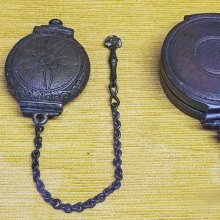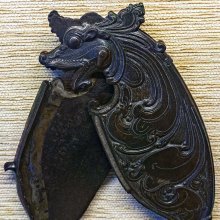Upakarana, Upakaraṇa: 26 definitions
Introduction:
Upakarana means something in Buddhism, Pali, Hinduism, Sanskrit, Jainism, Prakrit, Marathi, Hindi. If you want to know the exact meaning, history, etymology or English translation of this term then check out the descriptions on this page. Add your comment or reference to a book if you want to contribute to this summary article.
Alternative spellings of this word include Upkaran.
Images (photo gallery)
(+8 more images available)
In Hinduism
Natyashastra (theatrics and dramaturgy)
Source: archive.org: Natya ShastraThe characteristics of the accessories (upakaraṇa):—And d at the production of a play (lit. here) one should use differently in relation to dramatis personae many kinds of accessories (upakaraṇa) demanded by the art of theatre. Now, all the manufactures or crafts that are executed in this world of moving and immobile objects, are to be known as the accessories in a performance. And to obtain them one is to go to a country which has got it. For [obtaining] such accessories in a dramatic production men have no other means.

Natyashastra (नाट्यशास्त्र, nāṭyaśāstra) refers to both the ancient Indian tradition (shastra) of performing arts, (natya—theatrics, drama, dance, music), as well as the name of a Sanskrit work dealing with these subjects. It also teaches the rules for composing Dramatic plays (nataka), construction and performance of Theater, and Poetic works (kavya).
Jyotisha (astronomy and astrology)
Source: Wisdom Library: Brihat Samhita by VarahamihiraUpakaraṇa (उपकरण) refers to “emblems”, according to the Bṛhatsaṃhitā (chapter 3), an encyclopedic Sanskrit work written by Varāhamihira mainly focusing on the science of ancient Indian astronomy astronomy (Jyotiṣa).—Accordingly, “The dark spots, also known as ketus, the sons of Rāhu are Tāmasa, Kīlaka and the like, and are 33 in number. How they affect the earth depends upon their color, position and shape. [...] If the solar spots should be of the shape of the emblems of royalty [i.e., rāja-upakaraṇa] such as chatra (umbrella), dhvaja (flag staff) and cāmara (hairy fan) and the like, the reigning prince will be dethroned and a foreign prince will begin to reign. If the spots should appear like sparks of fire, like the smoke and the like, his subjects will suffer”.

Jyotisha (ज्योतिष, jyotiṣa or jyotish) refers to ‘astronomy’ or “Vedic astrology” and represents the fifth of the six Vedangas (additional sciences to be studied along with the Vedas). Jyotisha concerns itself with the study and prediction of the movements of celestial bodies, in order to calculate the auspicious time for rituals and ceremonies.
Purana and Itihasa (epic history)
Source: archive.org: Shiva Purana - English TranslationUpakaraṇa (उपकरण) refers to “one who is engaged in rendering help (to others)” and is used to describe Sage Nārada, according to the Śivapurāṇa 2.3.8.—Accordingly, as Himavat said to Sage Nārada:—“O sage Nārada, of good knowledge, O lord, foremost among the sons of Brahmā, you are omniscient. You are sympathetic. You are engaged in rendering help to others [i.e., para-upakaraṇa]. Please read the horoscope of my daughter and tell me about her good and bad fortune. Whose beloved wife will my fortunate daughter be?”.

The Purana (पुराण, purāṇas) refers to Sanskrit literature preserving ancient India’s vast cultural history, including historical legends, religious ceremonies, various arts and sciences. The eighteen mahapuranas total over 400,000 shlokas (metrical couplets) and date to at least several centuries BCE.
Pancaratra (worship of Nārāyaṇa)
Source: archive.org: Catalogue of Pancaratra Agama Texts1a) Upakaraṇa (उपकरण) refers to the “materials for worship”, as discussed in chapter 23 (Kriyāpāda) of the Padmasaṃhitā: the most widely followed of Saṃhitā covering the entire range of concerns of Pāñcarātra doctrine and practice (i.e., the four-fold formulation of subject matter—jñāna, yoga, kriyā and caryā) consisting of roughly 9000 verses.—Description of the chapter [pūjā-upakaraṇalakṣaṇa-vidhi]: Bhagavān says he will now describe and explain the utensils and instruments needed for worship (in the temple).
The following worship-materials (upakaraṇa) are discussed:
- standing dīpa-fixture,
- water vessels needed for arghya,
- naivedya,
- pānīya,
- darpaṇa-mirror,
- shower-plate,
- patākā (flag),
- snānapātra,
- ghaṇṭā (bell),
- camphor-holder,
- balipātra,
- ātapatra (umbrella),
- camara (whisk).
Note: Also see chapter 25: Pratiṣṭhopakaraṇa (“materials for sanctification ceremonies”).
1b) Upakaraṇa (उपकरण) refers to the “instruments” (used in liturgical worship), as discussed in chapter 11 of the Mārkaṇḍeyasaṃhitā: a Pāñcarātra text comprising some 2200 Sanskrit verses mainly dealing with temple-building, iconography, pūjā (worship procedures), utsava (festivities) and prāyaścitta (expiatory measures).—Description of chapter [ārādhana-upakaraṇa]:
The various paraphernalia used in worship are described and discussed:
- the nirājana-instrument for holding camphor (1-8),
- the dīpa-lamp (9-14a), the pādukā (14b-16a1),
- the ghaṇṭā-bell (16a2-22a),
- various patra-vessels (22b-33a, 46b-52a, 77-79),
- the chatra-umbrella (33b-35a),
- the darpaṇa-mirror (35b-38),
- the cāmara-whisk (39-46a).
1c) Upakaraṇa (उपकरण) refers to the “articles (of worship)”, as discussed in the twenty-seventh chapter of the Nāradīyasaṃhitā: a Pāñcarātra document comprising over 3000 verses in 30 chapters presenting in a narrative framework the teachings of Nārada to Gautama, dealing primarily with modes of worship and festivals.—Description of the chapter [yāga-upakaraṇa-vidhi]: Gautama asks Nārada about the articles (upakaraṇa) to be used in nitya and naimittika services (1). [...] Nārada then commences into detail, first by giving measurements, specifications and purifications for the kuṇḍa (fire-pits) and the paraphernalia used in fire-offerings (6-31). [...]
2) Upakaraṇa (उपकरण) [=upakaraṇamantra] refers to the “auxiliary mantras”, as discussed in the eighth chapter of the Jayākhyasaṃhitā: a Pāñcarātra Āgama text composed of 4500 verses in 33 chapters dealing with topics such as mantra (formulas), japa (repetitions), dhyāna (meditations), mudrā (gesticulations), nyāsa (concentrations) etc.—Description of the chapter [upakaraṇa-mantra-uddhāra]:—Ādhāramantras (2-17a) and 6 sub-types, Āsanamantras and 6 sub-types (19-38) are given here. Other mantras also are given. In each case the form is given in esoteric language, followed by instructions on how to meditate upon the mantra (39-125a).

Pancaratra (पाञ्चरात्र, pāñcarātra) represents a tradition of Hinduism where Narayana is revered and worshipped. Closeley related to Vaishnavism, the Pancaratra literature includes various Agamas and tantras incorporating many Vaishnava philosophies.
In Buddhism
Mahayana (major branch of Buddhism)
Source: Wisdom Library: Maha Prajnaparamita SastraUpakaraṇa (उपकरण) refers to “various utensils” and is mentioned among the “material benefits” granted by the Bodhisattva, according to the Mahāprajñāpāramitāśāstra chapter XLVI.—Accordingly, “other utensils (upakaraṇa), i.e., everything that beings have need of. As it would be impossible to mention them completely, the sūtra gathers them all together into one group”.
Source: De Gruyter: A Buddhist Ritual Manual on AgricultureUpakaraṇa (उपकरण) refers to “copious acquisitions” [?], according to the Vajratuṇḍasamayakalparāja, an ancient Buddhist ritual manual on agriculture from the 5th-century (or earlier), containing various instructions for the Sangha to provide agriculture-related services to laypeople including rain-making, weather control and crop protection.—Accordingly, “Now there lived a Brahmin called Viṣṇudatta in Navanagara. He was wealthy with great riches, great revenues; he was endowed with copious acquisitions (upakaraṇa-saṃpanna) and means of subsistence. He had mastered the Vedas and Vedāṅgas. He was a mantra-reciter and mantra-practitioner. He summoned Nāgas again and again. He sacrificed fire oblations. [...]”.

Mahayana (महायान, mahāyāna) is a major branch of Buddhism focusing on the path of a Bodhisattva (spiritual aspirants/ enlightened beings). Extant literature is vast and primarely composed in the Sanskrit language. There are many sūtras of which some of the earliest are the various Prajñāpāramitā sūtras.
In Jainism
General definition (in Jainism)
Source: Encyclopedia of Jainism: Tattvartha Sutra 6: Influx of karmasUpakaraṇa (उपकरण).—One of the two types of saṃyoga (combining);—What is meant by ‘combining implements’ (upakaraṇa-saṃyoga)? To wipe cold books /body, water pot etc by warm whisk or to combine hot and cold implements is combining implements. It can also be defined as assembling things together for any act or effect.
Source: Encyclopedia of Jainism: Tattvartha Sutra 2: the Category of the livingUpakaraṇa (उपकरण, “instruments”) refers to one of the two types of dravyendriya (physical sense organ), according to the 2nd-century Tattvārthasūtra 2.15. Dravyendriya represents one of the to types of indriya (sense-organs) of which there are five (pañcendriya)
What is the meaning of instrument /means (upakaraṇa)? It means an entity which assists in the completion or protection of the formation. How many types of instruments are there and which are those? These are two namely external and internal. What are the external instruments? For example the eye lids and the eye lashes are the instruments of the eye sense. What is the meaning of internal formations? Formations inside the external physical sense organ etc. for example retina, white and black balls inside the eye.

Jainism is an Indian religion of Dharma whose doctrine revolves around harmlessness (ahimsa) towards every living being. The two major branches (Digambara and Svetambara) of Jainism stimulate self-control (or, shramana, ‘self-reliance’) and spiritual development through a path of peace for the soul to progess to the ultimate goal.
Languages of India and abroad
Pali-English dictionary
Source: BuddhaSasana: Concise Pali-English Dictionaryupakaraṇa : (nt.) instrument; outfit; utensils; requisites; help; support; provisions.
Source: Sutta: The Pali Text Society's Pali-English DictionaryUpakaraṇa, (nt.) (fr. upa + kṛ) help, service, support; means of existence, livelihood D. II, 340; A. II, 86; J. I, 7; PvA. 60 (commodities), 133 (°manussa, adj. suitable, fit); Sdhp. 69. In general any instrument or means of achieving a purpose, viz. apparatus of a ship J. IV, 165; tunnavaya° a weaver’s outfit J. II, 364; dabb° fit to be used as wood Vism. 120; dān° materials for a gift PvA. 105 (so read & cp. upakkhaṭa); nahān° bathing requisites VvA. 248; vitt° luxuries A. V, 264 sq. , 283, 290 sq.; PvA. 71. (Page 139)

Pali is the language of the Tipiṭaka, which is the sacred canon of Theravāda Buddhism and contains much of the Buddha’s speech. Closeley related to Sanskrit, both languages are used interchangeably between religions.
Marathi-English dictionary
Source: DDSA: The Molesworth Marathi and English Dictionaryupakaraṇa (उपकरण).—n (S) An instrument or implement; a means. 2 A constituting or a subsidiary particular, an ingredient, an element. 3 or upakaraṇēṃ n A common term for the articles used in dēvapūjā (bells, censers, dishes, vessels). 4 Used pl The calculations made as preparatory to the framing of an almanac. 5 pl The insignia of royalty.
--- OR ---
upākaraṇa (उपाकरण).—n S upākarma n S The annual ceremony of renewing the sacrificial or the characteristic thread. 2 Studying the Vedas after investiture with the thread.
Source: DDSA: The Aryabhusan school dictionary, Marathi-Englishupakaraṇa (उपकरण).—n An instrument. A constitu- ent element. Apparatus.
--- OR ---
upākaraṇa (उपाकरण).—n The annual ceremony of renewing the sacrificial or the characteristic thread.
Marathi is an Indo-European language having over 70 million native speakers people in (predominantly) Maharashtra India. Marathi, like many other Indo-Aryan languages, evolved from early forms of Prakrit, which itself is a subset of Sanskrit, one of the most ancient languages of the world.
Sanskrit dictionary
Source: DDSA: The practical Sanskrit-English dictionaryUpakaraṇa (उपकरण).—
1) Doing service or favour, helping, assisting.
2) Material, implement, instrument, means; यथैवोपकरणवतां जीवितं तथैव ते जीवितं स्यात् (yathaivopakaraṇavatāṃ jīvitaṃ tathaiva te jīvitaṃ syāt) Bṛ. Up.2.4.2.; स्वेषूपकरणेषु (sveṣūpakaraṇeṣu) Uttararāmacarita 5; °द्रव्यम् (dravyam) Mṛcchakaṭika 3; उपकरणीभावमायाति (upakaraṇībhāvamāyāti) Uttararāmacarita 3.3 serve as helping instruments, or assistants; परोप- कारोपकरणं शरीरम् (paropa- kāropakaraṇaṃ śarīram) K.27; so स्नान° (snāna°) bathing materials; Pañcatantra (Bombay) 1; व्यायाम° (vyāyāma°) athletic materials; आत्मा परोपकरणीकृतः (ātmā paropakaraṇīkṛtaḥ) H.2.24; K.8,12,198,24; Y.2.276, Manusmṛti 9.27.
3) An engine, machine, apparatus, paraphernalia (in general).
4) Means of subsistence, anything supporting life.
5) A means or expedient; कर्म°, वेद°, यज्ञ° (karma°, veda°, yajña°) &c.
6) Fabricating, composing, elaborating.
7) The insignia of royalty.
8) The attendants of a king.
Derivable forms: upakaraṇam (उपकरणम्).
--- OR ---
Upākaraṇa (उपाकरण).—
1) An invitation to begin, bringing near; पवमान°, प्रातरनुवाक° (pavamāna°, prātaranuvāka°) &c.
2) A term given to certain sentences called Praiṣas (with which one priest calls another to perform a sacrifice).
3) Immolation, sacrifice of an animal consecrated according to rites.
4) Preparation, beginning, commencement.
5) Commencement of reading the Veda after the performance of the preparatory rite; cf. उपाकर्मन् (upākarman); वेदोपाकरणाख्यं कर्म करिष्ये (vedopākaraṇākhyaṃ karma kariṣye) Srāvaṇī-mantra.
Derivable forms: upākaraṇam (उपाकरणम्).
Source: Cologne Digital Sanskrit Dictionaries: Edgerton Buddhist Hybrid Sanskrit DictionaryUpakaraṇa (उपकरण).—= bhoga, food: Bodhisattvabhūmi 246.24 upakaraṇa-vaikalya-jaṃ (duḥkham), one of 5 kinds of duḥkha, clearly = 293.10 bhoga-vaikalya-duḥkha-, pain due to defects in food; probably in this meaning Bodhisattvabhūmi 11.1 upakaraṇa- vikalasya jīvikāpekṣāyaṃ caturtha upakleśaḥ; Mūla-Sarvāstivāda-Vinaya iii.19.20; 134.10. Cf. upakāraṇa.
--- OR ---
Upakāraṇa (उपकारण).—(?) (compare AMg. uvagāraṇa = Sanskrit upakāra? or for Sanskrit and Pali upakaraṇa?), in (Ārya-)Mañjuśrīmūlakalpa 48.10 evaṃ laḍḍukāgarbhoktārakaviśeṣān (? seems corrupt) pūpopa- kāraṇān sarvadevabhūtagaṇān sarvasattvāṃś ca mantrope- tān vidhinā niryātayet. We seem to need dat. instead of acc. forms for °gaṇān and °sattvāmś (as in the following parallel sentence); with that change, pūpopakāraṇān might mean benefactions consisting of cakes, or instruments (compare upakaraṇa) of (making) cakes; or, with a meaning character- istic of upakaraṇa in Pali rather than Sanskrit, commodities consisting of cakes; or finally, if = [Buddhist Hybrid Sanskrit] upakaraṇa in Bodhisattvabhūmi 246.24 (see s.v.), food consisting of cakes.
Source: Cologne Digital Sanskrit Dictionaries: Shabda-Sagara Sanskrit-English DictionaryUpakaraṇa (उपकरण).—n.
(-ṇaṃ) 1. Apparatus, paraphernalia, as the vessels and offerings at a sacrifice. 2. Implements, machines. 3. The insignia of royalty. 4. Sauces, condiments. 5. Helping, assisting. 6. Object of art or science, fabricating, composing, &c. 7. Means of subsistence, any thing supporting life. E. upa implying command or help, kṛ to make, lyuṭ aff.
--- OR ---
Upākaraṇa (उपाकरण).—n.
(-ṇaṃ) 1. Performance of a preparatory rite before reading the Vedas. 2. Immolation, sacrifice of an animal duly consecrated. E. upa and āṅ prefixed to kṛ to do, aff. lyuṭ.
Source: Cologne Digital Sanskrit Dictionaries: Benfey Sanskrit-English DictionaryUpakaraṇa (उपकरण).—i. e. upa-kṛ + ana, n. Benefitting, [Pañcatantra] 86, 3. 2. Implements, [Yājñavalkya, (ed. Stenzler.)] 2, 276. 3. Complement, [Mānavadharmaśāstra] 2, 105 (of the Veda, viz. the Vedāngas).
Source: Cologne Digital Sanskrit Dictionaries: Cappeller Sanskrit-English DictionaryUpakaraṇa (उपकरण).—[neuter] doing a service, helping, assistance; instrument, supplement, means, expedient; p. ṇavant.
--- OR ---
Upākaraṇa (उपाकरण).—[neuter] bringing near, fetching, also = seq.
Source: Cologne Digital Sanskrit Dictionaries: Aufrecht Catalogus Catalogorum1) Upākaraṇa (उपाकरण) as mentioned in Aufrecht’s Catalogus Catalogorum:—Āpast. B. 1, 146.
2) Upākaraṇa (उपाकरण):—[dharma] L.. 566.
Source: Cologne Digital Sanskrit Dictionaries: Monier-Williams Sanskrit-English Dictionary1) Upakaraṇa (उपकरण):—[=upa-karaṇa] a etc. See upa- √1. kṛ.
2) [=upa-karaṇa] [from upa-kṛ] b n. the act of doing anything for another, doing a service or favour, helping, assisting, benefiting, [Pañcatantra; Sāhitya-darpaṇa; Subhāṣitāvali] etc.
3) [v.s. ...] instrument, implement, machine, engine, apparatus, paraphernalia (as the vessels at a sacrifice etc.), [Kātyāyana-śrauta-sūtra; Śāṅkhāyana-gṛhya-sūtra; Yājñavalkya; Manu-smṛti] etc.
4) [v.s. ...] anything added over and above, contribution, expedient
5) [v.s. ...] means of subsistence, anything supporting life
6) [v.s. ...] any object of art or science
7) [v.s. ...] anything fabricated, [Manu-smṛti; Suśruta; Kathāsaritsāgara; Caraka] etc.
8) [v.s. ...] the insignia of royalty, [Horace H. Wilson]
9) [v.s. ...] the attendants of a king, [cf. Lexicographers, esp. such as amarasiṃha, halāyudha, hemacandra, etc.]
10) [v.s. ...] (according to some also) heaping earth ([from] √kṝ), [Viṣṇu-smṛti, viṣṇu-sūtra, vaiṣṇava-dharma-śāstra]
11) Upākaraṇa (उपाकरण):—[=upā-karaṇa] [from upā-kṛ] n. the act of bringing near, fetching, [Śatapatha-brāhmaṇa; Pāraskara-gṛhya-sūtra] etc.
12) [v.s. ...] setting about, preparation, beginning, commencing, [Āpastamba-dharma-sūtra; Āśvalāyana-śrauta-sūtra] & [Āśvalāyana-gṛhya-sūtra; Kātyāyana-śrauta-sūtra] etc.
13) [v.s. ...] commencement of reading the Veda (after the performance of preparatory rites, as initiation etc.), [Śāṅkhāyana-gṛhya-sūtra iv, 5, 1]
14) [v.s. ...] Name of a particular Stotra or prayer at sacrifices, [Kātyāyana-śrauta-sūtra iii.]
Source: Cologne Digital Sanskrit Dictionaries: Yates Sanskrit-English Dictionary1) Upakaraṇa (उपकरण):—[upa-karaṇa] (ṇaṃ) 1. n. Apparatus; insignia; sauces; helping; means.
2) Upākaraṇa (उपाकरण):—[upā+karaṇa] (ṇaṃ) 1. n. Study of the Vedas after initiation, immolation.
Source: DDSA: Paia-sadda-mahannavo; a comprehensive Prakrit Hindi dictionary (S)Upakaraṇa (उपकरण) in the Sanskrit language is related to the Prakrit words: Uvagaraṇa, Uvayaraṇa, Uvayāraṇa, Oaraṇa.
[Sanskrit to German]
Sanskrit, also spelled संस्कृतम् (saṃskṛtam), is an ancient language of India commonly seen as the grandmother of the Indo-European language family (even English!). Closely allied with Prakrit and Pali, Sanskrit is more exhaustive in both grammar and terms and has the most extensive collection of literature in the world, greatly surpassing its sister-languages Greek and Latin.
Hindi dictionary
Source: DDSA: A practical Hindi-English dictionaryUpakaraṇa (उपकरण) [Also spelled upkaran]:—(nm) appliance; equipment, apparatus.
...
Kannada-English dictionary
Source: Alar: Kannada-English corpusUpakaraṇa (ಉಪಕರಣ):—
1) [noun] a service or favour done to another.
2) [noun] an implement, instrument, apparatus, etc. used as a means to do something or bring something about.
3) [noun] a royal contingent; attendants of a king.
--- OR ---
Upākaraṇa (ಉಪಾಕರಣ):—
1) [noun] a bringing closer; a receiving; a reception.
2) [noun] commencement of reading of the Vedas after the performance of the preparatory rites.
3) [noun] the act of consecration of an animal intended to be immolated in a sacrifice.
Kannada is a Dravidian language (as opposed to the Indo-European language family) mainly spoken in the southwestern region of India.
Nepali dictionary
Source: unoes: Nepali-English DictionaryUpakaraṇa (उपकरण):—n. means; material; implements; apparatus; accessories; tools; instruments;
Nepali is the primary language of the Nepalese people counting almost 20 million native speakers. The country of Nepal is situated in the Himalaya mountain range to the north of India.
See also (Relevant definitions)
Partial matches: Yu, Kaara, Upa, Karana, Kara.
Starts with: Upakaranageyi, Upakaranalakshana, Upakaranalakshanavidhi, Upakaranam, Upakaranamantra, Upakaranamantroddhara, Upakaranartha, Upakaranasamagri, Upakaranavant, Upakaranavat, Upakaranavidhi.
Query error!
Full-text (+62): Grihopakarana, Rajopakarana, Upakaranavidhi, Rajyopakarana, Yajnopakarana, Pujopakarana, Patropakarana, Yuddhopakarana, Karmopakarana, Upakaranartha, Shastropakarana, Paropakarana, Manopakarana, Punarupakarana, Smaropakarana, Upagrahana, Upakaranavat, Upakaranam, Akshopakarana, Aupakarana.
Relevant text
Search found 41 books and stories containing Upakarana, Upa-kara-yu, Upa-karana, Upa-karaṇa, Upā-karaṇa, Upakaraṇa, Upākaraṇa, Upakāraṇa; (plurals include: Upakaranas, yus, karanas, karaṇas, Upakaraṇas, Upākaraṇas, Upakāraṇas). You can also click to the full overview containing English textual excerpts. Below are direct links for the most relevant articles:
Tattvartha Sutra (with commentary) (by Vijay K. Jain)
Verse 2.17 - The physical-sense (dravyendriya) < [Chapter 2 - Category of the Living]
Verse 6.9 - The non-living substratum (ajīva-adhikaraṇa) < [Chapter 6 - Influx of Karmas]
Verse 7.34 - The transgressions of Proṣadhopavāsa-vrata < [Chapter 7 - The Five Vows]
Agni Purana (by N. Gangadharan)
The Agnistoma Somayaga in the Shukla Yajurveda (by Madan Haloi)
Part 4.11: Animal sacrifice in honour of Agni and Soma < [Chapter 4 - The Agniṣṭoma Ritual]
Part 5.2: Morning Soma pressing (prātaḥsavana) < [Chapter 4 - The Agniṣṭoma Ritual]
Gobhila-grihya-sutra (by Hermann Oldenberg)
Amarakoshodghatana of Kshirasvamin (study) (by A. Yamuna Devi)
Education (3): Knowledge < [Chapter 4 - Cultural Aspects]
Vedic Sacrifices < [Chapter 4 - Cultural Aspects]
Yogadrstisamuccaya of Haribhadra Suri (Study) (by Riddhi J. Shah)
Chapter 4.3d - Kṣepa (distraction) < [Chapter 4 - The Eight Yogadṛṣṭis and the nature of a Liberated Soul]





